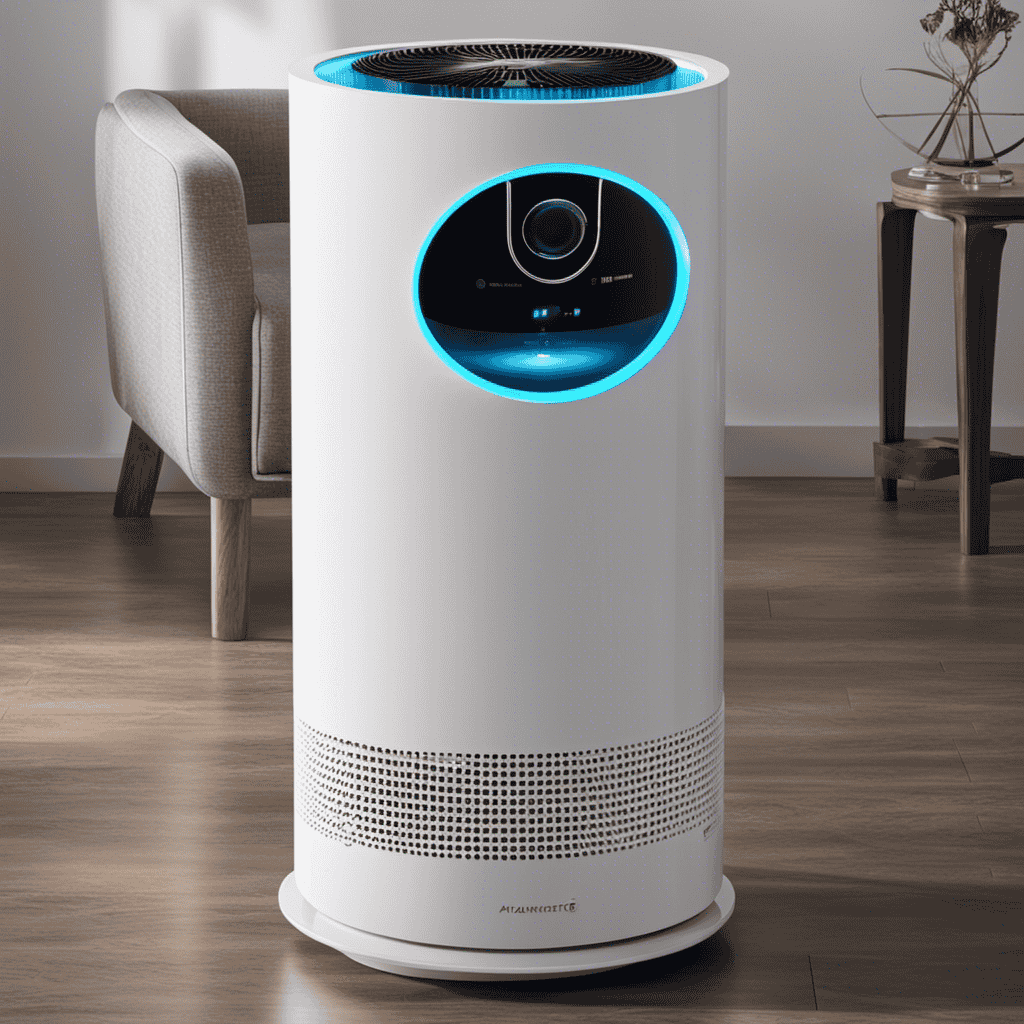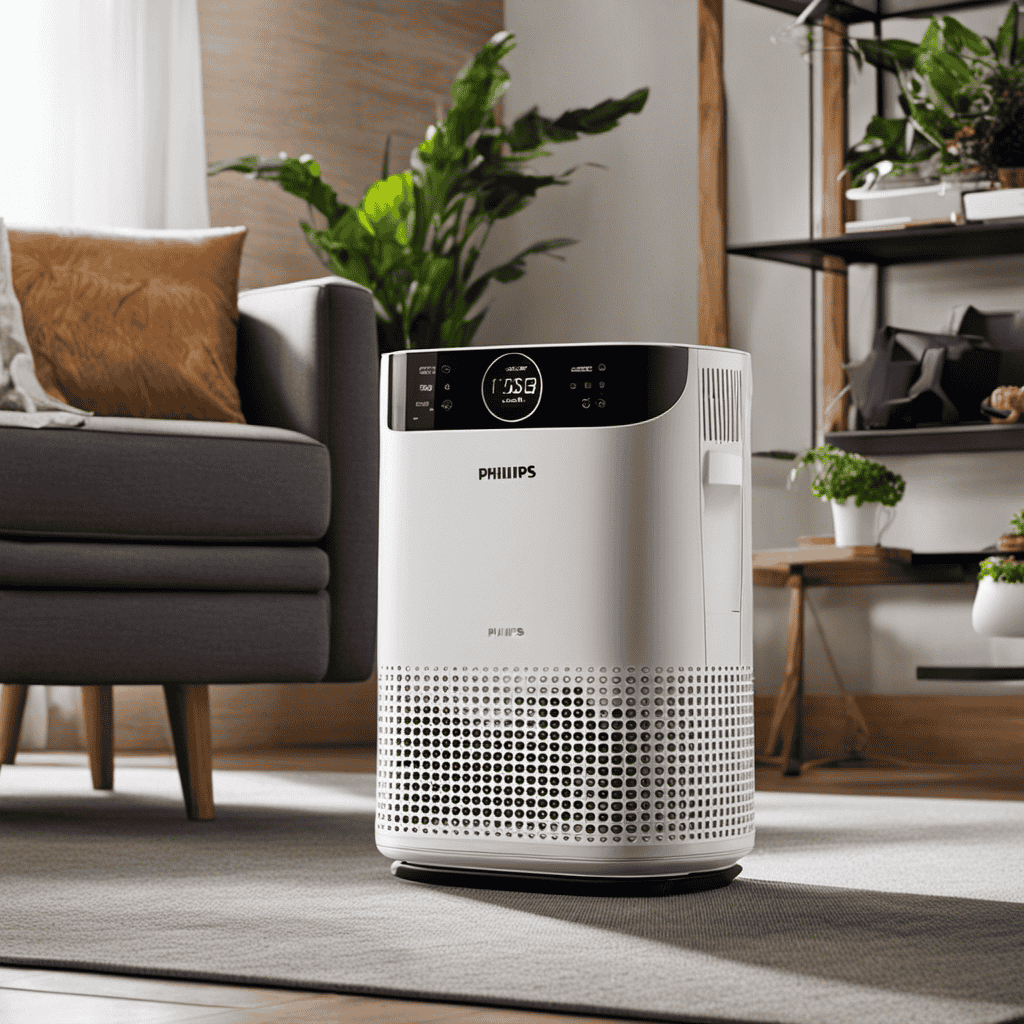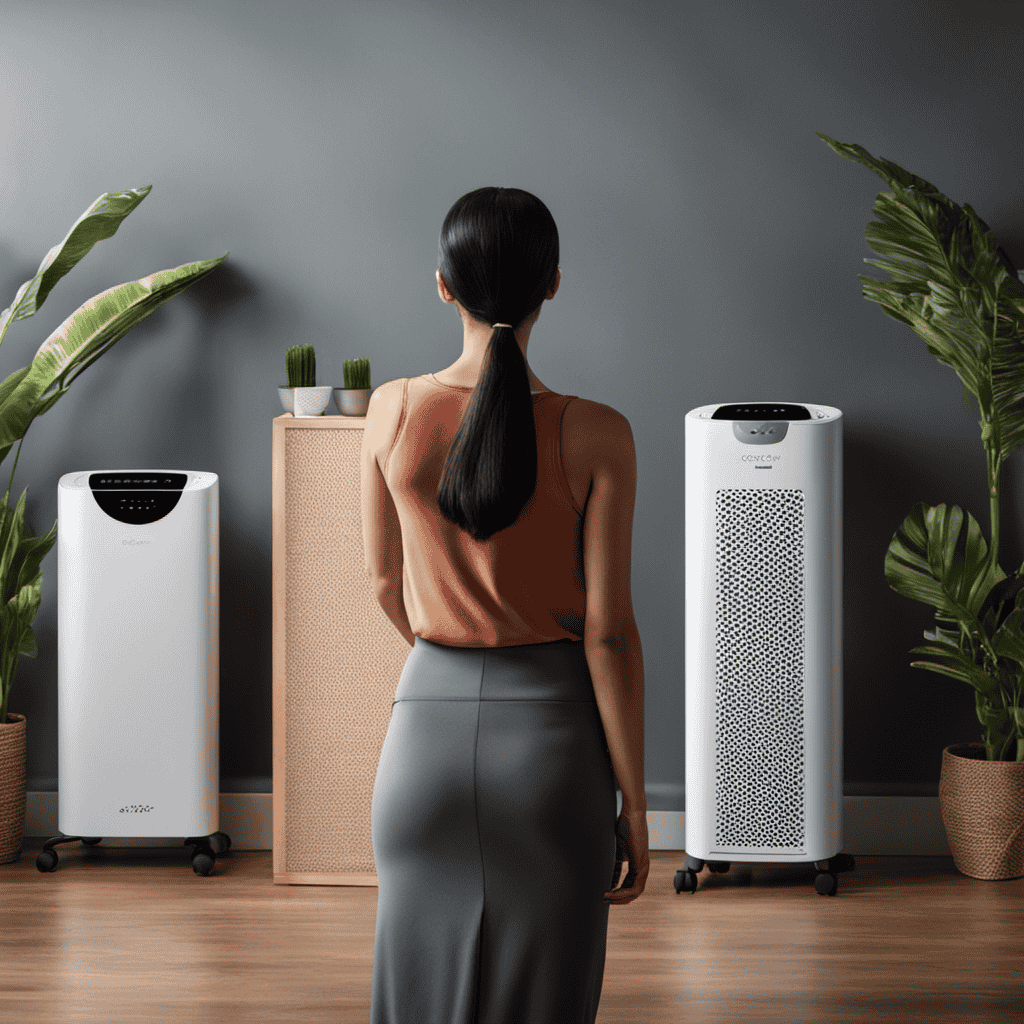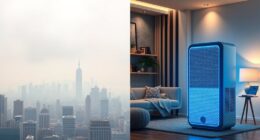As someone who is passionate about air quality, I have always been intrigued by the mysterious ‘PM’ in air purifiers. What exactly is it? And why is it significant?
Well, get ready to dive deep into the world of particulate matter (PM) and its impact on indoor air quality. In this article, we will explore the sources of PM, its health effects, and how air purifiers can effectively remove it.
So, buckle up and prepare to breathe easier with a comprehensive understanding of PM in air purifiers.
Key Takeaways
- PM refers to tiny solid or liquid particles in the air and is measured and classified based on size.
- PM is primarily generated from combustion processes and directly emitted into the atmosphere.
- PM has a significant impact on outdoor air quality and can cause respiratory and cardiovascular problems.
- Air purifiers with high-efficiency particulate air (HEPA) filters can effectively filter out PM, improving indoor air quality.
Understanding PM: An Overview
PM, or particulate matter, refers to tiny solid or liquid particles that are present in the air. These particles come from various sources such as combustion processes, industrial emissions, and natural sources like dust and pollen.
It is important to measure and classify PM in order to understand its composition and potential health effects. PM measurement techniques involve the use of specialized instruments like samplers and optical particle counters. These tools help in collecting samples and analyzing particle size, concentration, and composition.
PM is typically classified based on size, with PM10 referring to particles with a diameter of 10 micrometers or less, and PM2.5 referring to particles with a diameter of 2.5 micrometers or less.
Understanding PM and its classification is crucial for assessing air quality and implementing effective air purification strategies.
Differentiating PM From Other Air Pollutants
To understand the difference between PM and other pollutants, you can look at their sources and sizes. PM, or particulate matter, refers to tiny particles suspended in the air. It can be differentiated from pollutants like ozone based on their origins and composition. Here are four key points to consider:
- PM is primarily generated from combustion processes, such as vehicle emissions and industrial activities.
- Unlike ozone, which is formed through chemical reactions involving sunlight and pollutants like nitrogen oxides, PM is directly emitted into the atmosphere.
- PM particles vary in size, ranging from coarse particles (PM10) to fine particles (PM2.5) and ultrafine particles (PM0.1).
- The impact of PM on outdoor air quality is significant, as it can cause respiratory issues, cardiovascular problems, and even premature death.
Understanding these distinctions is crucial for developing effective strategies to mitigate the harmful effects of PM on outdoor air quality.
Now, let’s delve into the impact of PM on indoor air quality.
The Impact of PM on Indoor Air Quality
PM, or particulate matter, has a significant impact on respiratory health. This makes it an important consideration in maintaining indoor air quality.
Sources of indoor PM can vary. They include dust, cooking emissions, tobacco smoke, and pet dander.
To effectively filter out PM, it is crucial to use air purifiers with high-efficiency particulate air (HEPA) filters. These filters can capture particles as small as 0.3 micrometers.
PM and Respiratory Health
You should be aware that high levels of PM (particulate matter) in the air can negatively impact your respiratory health. PM refers to tiny particles and droplets suspended in the air, such as dust, pollen, smoke, and pollutants. These particles can easily enter your respiratory system, causing a range of health issues.
Here are four important facts to consider about PM and its effects on respiratory health:
-
PM and allergies: Exposure to PM can trigger allergies, leading to symptoms like sneezing, coughing, and itchy eyes. People with pre-existing respiratory conditions, such as asthma, may experience worsened symptoms due to PM.
-
PM and cardiovascular health: Studies have shown a link between PM exposure and an increased risk of cardiovascular diseases. PM can enter the bloodstream and cause inflammation, leading to heart attacks, strokes, and other cardiovascular problems.
-
PM size matters: The size of PM particles determines their ability to penetrate deep into the respiratory system. Fine particles (PM2.5) are particularly concerning as they can reach the lungs’ smallest airways and even enter the bloodstream.
-
Long-term effects: Prolonged exposure to high levels of PM can have long-term consequences on respiratory health. It can contribute to the development of chronic respiratory diseases, such as chronic obstructive pulmonary disease (COPD) and lung cancer.
To protect your respiratory health, it is crucial to monitor and reduce PM levels in the air, especially indoors. Using air purifiers with effective filtration systems can help remove PM particles, providing cleaner and healthier air to breathe.
Sources of Indoor PM
Indoor sources of PM include household activities like cooking, cleaning, and smoking. These activities release particles into the air that can have detrimental effects on our health. Cooking, especially when using high heat or frying, can produce smoke and greasy particles that contribute to indoor PM. Cleaning products, such as aerosol sprays and powders, can release fine particles that become suspended in the air. Smoking is a major source of PM, with both the smoke from the burning tobacco and the exhaled smoke containing harmful particles.
Exposure to indoor PM can lead to various health effects, including respiratory issues, allergies, and even cardiovascular problems. Understanding and minimizing these sources of indoor PM is crucial for maintaining good indoor air quality and protecting our health.
To effectively filter out indoor PM, it is important to invest in a high-quality air purifier.
Effective PM Filtration
Investing in a high-quality filtration system can effectively remove harmful particles from the air, improving indoor air quality and protecting your health. With advanced PM filtration techniques, these systems can capture even the smallest particles, ensuring cleaner and healthier air for you and your loved ones.
Here are some benefits of PM removal:
- Reduced respiratory issues: Removing PM from the air can help alleviate symptoms of asthma, allergies, and other respiratory conditions, providing relief and improving overall well-being.
- Enhanced sleep quality: Breathing cleaner air can promote better sleep by reducing irritants that can disrupt sleep patterns and cause discomfort.
- Increased productivity: Cleaner air can improve cognitive function and concentration, leading to increased productivity and efficiency in daily tasks.
- Long-term health protection: By removing PM, you can reduce the risk of long-term health issues associated with exposure to pollutants, such as heart disease, lung cancer, and respiratory infections.
Investing in a high-quality filtration system that effectively removes PM is a wise decision, as it not only improves indoor air quality but also helps safeguard your health in the long run.
Sources of PM in the Air
When it comes to sources of PM in the air, you’ll find that pollution from vehicles and industrial emissions are significant contributors. Industrial emissions refer to the release of pollutants into the atmosphere from factories, power plants, and other industrial activities. These emissions can contain a wide range of particulate matter, including PM2.5 and PM10, which are known to be harmful to human health. Outdoor pollution, caused by these industrial emissions and other sources like vehicle exhaust, can have serious consequences on air quality and public health. To provide a deeper understanding, here is a table showing the different types of industrial emissions and their associated particulate matter:
| Type of Industrial Emission | Particulate Matter Released |
|---|---|
| Power Plants | PM2.5, PM10 |
| Steel Manufacturing | PM2.5, PM10 |
| Cement Production | PM2.5, PM10 |
| Chemical Plants | PM2.5, PM10 |
| Oil Refineries | PM2.5, PM10 |
These examples highlight the diverse sources of PM in the air and the importance of addressing industrial emissions to reduce outdoor pollution.
The Health Effects of PM Exposure
When it comes to discussing the health effects of PM exposure, two key points that need to be addressed are the impact on respiratory health and the potential risks of long-term exposure.
PM, or particulate matter, is a complex mixture of solid and liquid particles suspended in the air. These particles can vary in size and composition, with the smaller ones being of particular concern as they can penetrate deep into the respiratory system and cause inflammation and other adverse effects.
Long-term exposure to PM has been linked to a range of respiratory conditions, including asthma, chronic obstructive pulmonary disease (COPD), and even lung cancer.
PM and Respiratory Health
If you’re concerned about your respiratory health, understanding the relationship between PM and air purifiers is essential. PM, or particulate matter, refers to tiny particles suspended in the air, such as dust, pollen, and smoke. These particles can have a significant impact on allergies and lung function. Here are four key points to consider:
-
PM and Allergies: High levels of PM can trigger allergic reactions, leading to symptoms like sneezing, coughing, and watery eyes. Air purifiers with HEPA filters can effectively capture and remove these allergens from the air, providing relief.
-
PM and Lung Function: Breathing in PM can harm lung function, especially in individuals with respiratory conditions like asthma or chronic obstructive pulmonary disease (COPD). Using an air purifier with a high CADR (Clean Air Delivery Rate) can help reduce PM levels, promoting better lung health.
-
Filter Efficiency: When choosing an air purifier, look for one that has a high-efficiency filter, like a HEPA filter. These filters can remove up to 99.97% of particles as small as 0.3 microns, ensuring cleaner air.
-
Maintenance: Regularly clean and replace the filters in your air purifier to maintain its effectiveness in capturing PM. Follow the manufacturer’s instructions for proper maintenance to ensure optimal performance.
Long-Term PM Exposure
In my previous discussion on PM and respiratory health, I highlighted the immediate impact of PM exposure on our well-being. However, it is also crucial to consider the long-term effects of prolonged exposure to PM pollutants. Continuous inhalation of PM can have serious implications for our long-term health.
To mitigate the risks associated with long-term PM exposure, it is essential to take proactive measures. One effective approach is the use of air purifiers equipped with advanced filtration systems. These devices can help remove PM particles from indoor spaces, reducing our overall exposure. By investing in high-quality air purifiers and regularly maintaining them, we can significantly decrease the concentration of PM in our immediate environment.
To further emphasize the importance of long-term PM exposure mitigation, I have provided a table below that compares the potential health effects of short-term and long-term PM exposure:
| Short-Term PM Exposure | Long-Term PM Exposure |
|---|---|
| – Respiratory irritation | – Chronic respiratory diseases |
| – Reduced lung function | – Increased risk of cardiovascular diseases |
| – Aggravation of asthma symptoms | – Premature death |
| – Allergic reactions | – Development of lung cancer |
PM Measurement Techniques and Standards
PM measurement techniques and standards play a crucial role in determining air quality levels. Accurate measurement of PM is essential for assessing the potential health risks associated with air pollution. Here are some key points to consider:
-
Sampling Methods: Various techniques, such as gravimetric sampling, optical particle counters, and beta attenuation monitors, are used to collect and measure PM samples.
-
Size Fractionation: PM is categorized into different size fractions (PM10, PM2.5, etc.) to understand their potential health impacts. Different instruments are used to measure specific size ranges.
-
Calibration and Quality Assurance: Regular calibration and quality assurance procedures are followed to ensure accurate and reliable PM measurements.
-
Standards and Guidelines: PM standards and guidelines, set by organizations like the World Health Organization (WHO) and the Environmental Protection Agency (EPA), provide benchmarks for acceptable PM levels.
PM Classification and Size Distribution
By categorizing PM into different size fractions, we can better understand its potential health impacts. PM, or particulate matter, refers to tiny particles suspended in the air that can be harmful to human health.
PM is classified based on its size distribution, which is crucial in determining its behavior and potential health effects. The classification is based on the aerodynamic diameter of the particles. PM is divided into different size fractions, such as PM10, PM2.5, and PM1, representing particles with aerodynamic diameters less than 10 micrometers, 2.5 micrometers, and 1 micrometer, respectively.
These different size fractions have varying abilities to penetrate the respiratory system. For example, PM10 particles are relatively larger and are trapped in the upper airways, while PM2.5 and PM1 particles can reach the deeper parts of the lungs, leading to more severe health effects.
Understanding the classification and size distribution of PM is essential for designing effective air purification systems and implementing strategies to reduce exposure to harmful particulate matter.
How Air Purifiers Remove PM
When it comes to air purifiers, understanding how they remove particulate matter (PM) is crucial. In this discussion, we will dive into the various PM filtration methods employed by air purifiers and explore their efficiency in purifying the air.
PM Filtration Methods
One way to filter PM in air purifiers is by using high-efficiency particulate air (HEPA) filters. These filters are designed to capture particles as small as 0.3 microns with an efficiency of 99.97%.
Here are some benefits of PM filtration techniques:
-
Improved air quality: PM filtration helps remove harmful particles such as dust, pollen, pet dander, and mold spores, improving the overall air quality in your space.
-
Reduced respiratory issues: By removing PM, air purifiers can alleviate symptoms of allergies, asthma, and other respiratory conditions, providing relief and improving breathing.
-
Cleaner environment: PM filtration reduces the presence of pollutants in the air, creating a cleaner and healthier environment for you and your family.
-
Enhanced sleep quality: Breathing in clean air promotes better sleep, allowing you to wake up feeling refreshed and rejuvenated.
By incorporating PM filtration techniques, air purifiers contribute to a healthier indoor environment.
Now, let’s explore the efficiency of purifiers in more detail.
Efficiency of Purifiers
Using high-efficiency filters ensures that harmful particles are effectively captured, improving the overall performance of air purifiers. Efficiency testing is a crucial step in determining the effectiveness of these filters.
Various filtration technologies are used in air purifiers to achieve efficient particle capture. HEPA (High-Efficiency Particulate Air) filters, for example, are widely used due to their high filtration efficiency. These filters can capture particles as small as 0.3 microns with an efficiency of 99.97%.
Other filtration technologies, such as activated carbon filters, are effective in removing odors and gases from the air.
Efficiency testing involves measuring the performance of these filters under controlled conditions, ensuring that they meet the required standards.
Choosing the Right Air Purifier for PM Removal
To find the right air purifier for PM removal, it’s important to consider the size of the room you want to purify. Different air purifiers are designed to handle different room sizes, so it’s crucial to choose one that is appropriate for your space.
Here are some important factors to consider when selecting an air purifier for PM removal:
- Filter Efficiency: Look for an air purifier that uses HEPA filters, as they are highly effective in capturing small particles, including PM.
- CADR Rating: Check the Clean Air Delivery Rate (CADR) of the air purifier, which indicates its ability to remove PM from the air.
- Noise Level: Consider the noise level of the air purifier, especially if you plan to use it in a bedroom or office.
- Maintenance: Find out how often the filters need to be replaced and how easy it is to clean the purifier.
By considering these factors, you can choose the right air purifier to effectively remove PM from your indoor air.
In the next section, we will discuss some tips for reducing PM levels in your home.
Tips for Reducing PM Levels in Your Home
Consider implementing these simple tips to reduce PM levels in your home.
One effective technique is to use air purifiers, which can help remove PM particles from the air. Look for purifiers with HEPA filters, as they’re designed to capture even the smallest particles. Placing the purifier in the most frequently used room can maximize its effectiveness. Additionally, regularly cleaning and maintaining the purifier is crucial to ensure optimal performance.
Another way to reduce PM levels is by keeping your home clean. Vacuuming regularly with a vacuum cleaner equipped with a HEPA filter can help remove PM particles from carpets and rugs. Dusting surfaces with a microfiber cloth can also prevent PM particles from accumulating.
Maintaining and Cleaning Your Air Purifier for PM Efficiency
Regularly cleaning and maintaining your purifier is crucial to ensure optimal performance and maximize its efficiency in reducing PM levels. Neglecting proper maintenance can lead to a decrease in the purifier’s effectiveness, resulting in poor air quality.
To keep your air purifier in top condition, here are some important tips to follow:
-
Cleaning Frequency: Clean the pre-filter and HEPA filter at least once a month or as recommended by the manufacturer.
-
Thorough Cleaning: Remove the filters and gently vacuum them to remove dust and debris. Wipe the exterior of the purifier with a soft cloth.
-
Avoiding Water Damage: Never wash the filters with water, as it can damage their functionality. Only use dry cleaning methods.
-
Replacing Filters: Regularly check the filters for signs of wear and tear. Replace them as needed to maintain optimal performance.
By following these maintenance tips, you can ensure that your air purifier continues to effectively reduce PM levels in your home.
Avoiding common mistakes like improper cleaning frequency or water damage will prolong the lifespan of your purifier and provide cleaner, healthier air for you and your family.
Frequently Asked Questions
How Often Should I Replace the Filters in My Air Purifier to Maintain Effective PM Removal?
I replace the filters in my air purifier every 6 months to ensure effective PM removal. PM, or particulate matter, can negatively impact indoor air quality, so regular maintenance is crucial for optimal performance.
Can Air Purifiers Eliminate All Types of PM, Including Both Coarse and Fine Particles?
Yes, air purifiers can eliminate both coarse and fine particles, including PM. They use filters to trap and remove these particles from the air, helping to alleviate allergy symptoms and improve air quality. Regular filter maintenance is important for optimal PM removal.
Are There Any Specific Air Purifier Features or Technologies That Are More Effective at Removing Pm?
There are specific air purifier features and technologies that are more effective at removing PM, such as smart air purifiers with HEPA filters. These filters can capture both coarse and fine particles, providing cleaner air.
Is It Necessary to Run Your Air Purifier Continuously to Effectively Reduce PM Levels?
To effectively reduce PM levels, running your air purifier continuously is necessary. Factors to consider when choosing one for PM reduction include the effectiveness of air purifiers in reducing PM levels and their specific features or technologies.
Can Air Purifiers Remove PM That Is Generated Indoors, Such as From Cooking or Smoking?
Air purifiers can effectively remove indoor PM, like cooking or smoking emissions. They improve air quality by capturing and trapping PM particles, reducing health risks associated with PM exposure. Air purifier efficiency ensures maximum health benefits.
What Is the Difference Between Pm and Pm2.5 in Air Purifiers?
PM2.5 in air purifiers refers to fine particulate matter with a diameter of 2.5 micrometers or smaller. This includes pollutants like dust, pollen, and smoke that can be harmful to health. Air purifiers equipped to filter PM2.5 are more effective in providing clean and healthy indoor air.
Conclusion
Wow, who knew that PM in the air could cause so much trouble?
After learning about the various sources and health effects of PM exposure, it’s clear that having an air purifier is essential for maintaining indoor air quality.
With the right air purifier, you can effectively remove PM particles and breathe cleaner air.
Don’t forget to follow the tips for reducing PM levels in your home and regularly clean and maintain your air purifier for maximum efficiency.
Say goodbye to pesky PM and hello to fresh, clean air!










